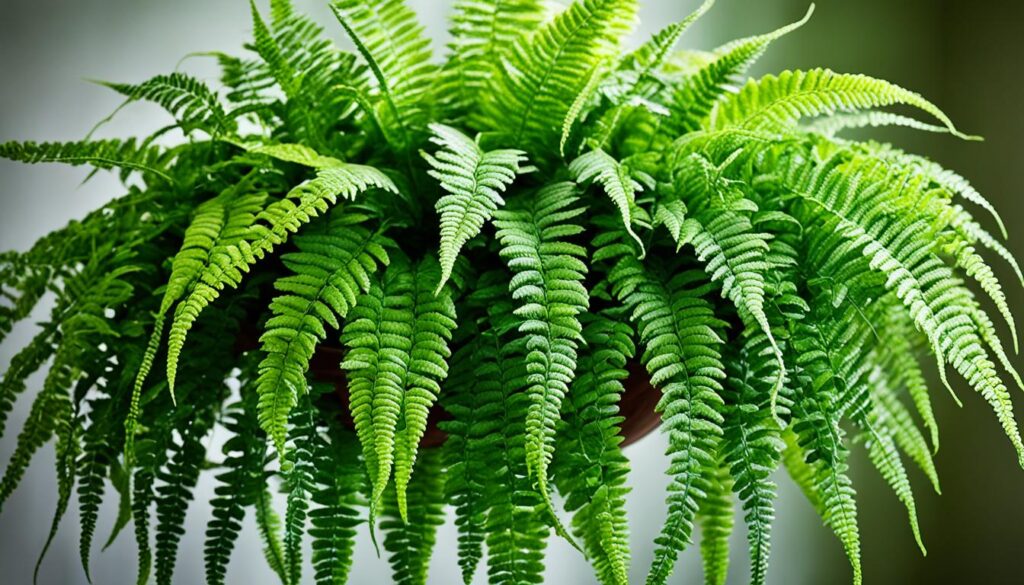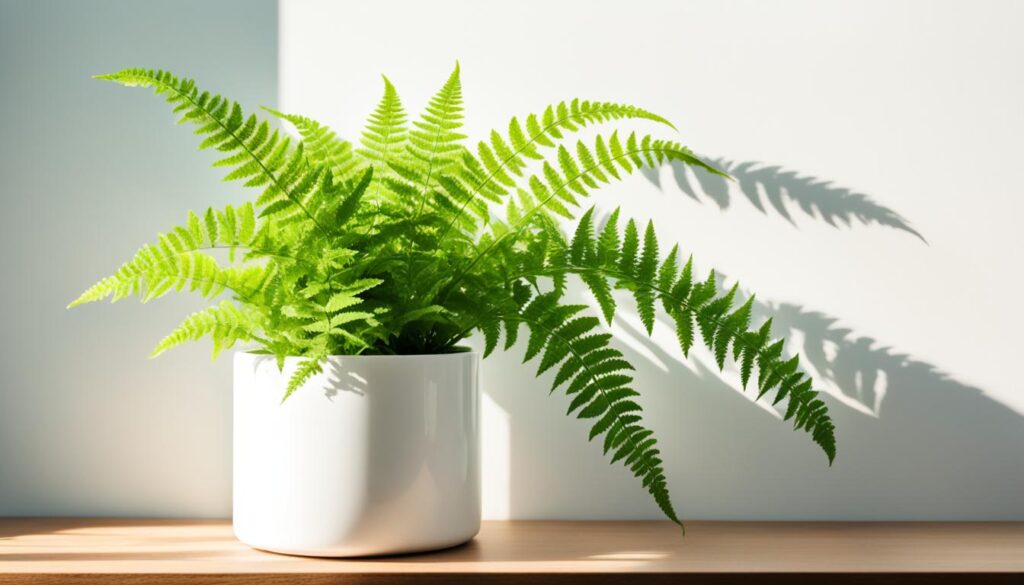
Do you dream of turning your home into a lush, green oasis? Ferns plants are your answer. These ancient plants are not only resilient but also add beauty to any space. They bring elegance and peace to your home. But why are ferns so special, and how can you add them to your space? Find out in this guide, where we explore the benefits, types, and care of these beautiful plants.
The Enchanting World of Ferns Plants
Ferns are among the oldest living plants, with a history that goes back millions of years. They have adapted to live in many places, from tropical forests to temperate woodlands. Ferns have a timeless beauty and also offer benefits that make them great for indoor spaces.
Ferns: Ancient Plants with Modern Appeal
Ferns have always been linked to symbols of peace, strength, and new beginnings. In the Victorian era, they became popular for decorating homes and gardens. Today, they still symbolize resilience and adaptability, showing off their beauty in various shapes, sizes, and colors.
From the soft Boston fern to the leather fern with its shiny leaves, each fern is unique. These plants can live in many environments, showing us hope and strength in our modern world.
Bringing the Outdoors In: Benefits of Indoor Ferns
Ferns are not just pretty; they also have practical benefits for indoor spaces. They help purify the air by removing toxins and releasing oxygen, which is good for your health. Ferns can also make your home feel calm and relaxing, which can help reduce stress and improve breathing for people with allergies or asthma.
These plants are safe for pets, making them a great choice for homes with animals. Ferns fit well with many decorating styles, from classic to modern. They add beauty and life to any room.

Popular Ferns Plants for Your Indoor Oasis
There are many ferns you can pick for your indoor space, each with its own special look. The Boston Fern has classic cascading fronds. The Bird’s Nest Fern has a striking rosette shape. These plants can make any indoor area look better.
Boston Fern: The Classic Cascading Beauty
The Boston Fern is a favorite among indoor plant lovers. It’s known for its long, feathery fronds that cascade down. This fern has bright green colors and a beautiful, flowing shape. It’s perfect for hanging baskets or high shelves, where it can really stand out.
Bird’s Nest Fern: Tropical Elegance in a Rosette
The Bird’s Nest Fern is different from the Boston Fern. It has wide, wavy fronds that form a beautiful rosette. Coming from tropical places in Southeast Asia and the Pacific, this fern brings a touch of the exotic indoors. Its unique look and bright green leaves make it great for shelves, tables, or terrariums.
Other popular ferns include the Staghorn Fern, Maidenhair Fern, Rabbit’s Foot Fern, Lemon Button Fern, Blue Star Fern, Japanese Painted Fern, Kimberly Queen Fern, and Crocodile Fern. Each one has its own special look and needs.

If you like the look of the Boston Fern or the Bird’s Nest Fern, these ferns can make your space feel like a lush oasis. They come in many shapes and colors. Ferns can bring natural beauty to your home, clean the air, and improve your health.
ferns plants: Versatile Greenery for Every Space
Ferns are versatile plants that fit well in many indoor spaces, from small apartments to big homes. They can add a touch of fern decor to small corners or create a lush oasis. You can put them in fern hanging baskets, on shelves, or in large rooms. This makes any area feel calm and connected to nature.
There are many ways to place ferns. Small ferns like the Fern Asparagus (Asparagus densiflorus ‘Sprengeri’) work well in fern containers on shelves. Larger ferns like the Moonlight Fern (Pteris cretica) can hang from the ceiling in fern hanging baskets, creating a lush look.
In big rooms or open spaces, ferns like the Bird’s Nest Fern (Asplenium nidus) stand out. Their big, tropical leaves and upright shape fill large areas with a calm, nature feel. The Black Rabbit Foot Fern (Davallia fejeensis) adds a fun touch with its furry rhizomes on shelves or pedestals.

No matter your home’s size or layout, ferns can fit right in. They let you try out different fern containers and setups. This turns your living spaces into green, nature-inspired places that bring the outdoors inside.
Caring for Your Ferns Plants
To keep your ferns healthy, you need to understand their care needs. They like their soil to stay moist, so make sure to water them regularly. It’s also key to keep the air around them humid, as many ferns do well in moist air.
Watering and Humidity Needs
Watering ferns is simple: keep the soil moist but not soaked. Let the top inch of soil dry out a bit before watering again. To keep humidity up, mist the leaves or use a humidifier.
Light and Temperature Requirements
Ferns need the right amount of light to thrive. They do best in bright, indirect light. Direct sunlight can burn their leaves. They also like temperatures between 60-75°F. Avoid sudden changes in temperature to keep them healthy.
Looking after ferns also means repotting, fertilizing, and winterizing them. Repotting every few years stops roots from getting too crowded. Fertilizing with a balanced liquid during the growing season helps them grow lush. With the right care, your ferns will add beauty to your home.
| Fern Care Requirement | Optimal Conditions |
|---|---|
| Watering | Keep soil consistently moist, but not waterlogged. Allow top inch to slightly dry between waterings. |
| Humidity | Maintain high humidity levels, around 40-50%. Mist leaves regularly or use a humidifier. |
| Light | Bright, indirect light. Avoid direct sunlight, which can scorch the fronds. |
| Temperature | Ideal range is 60-75°F. Protect from sudden temperature changes and drafts. |
| Soil | Well-draining potting mix with added perlite or sand for aeration. |
| Fertilizer | Use a balanced liquid fertilizer at half-strength every 2-4 weeks during the growing season. |
| Repotting | Repot every 2-3 years in spring to prevent root crowding and maintain vigorous growth. |
Choosing the Perfect Fern for Your Home
When picking the right fern for your home, think about the size and how it grows. Compact ferns like the Lemon Button Fern or Blue Star Fern are great for small spaces. They are easy to care for and add a touch of greenery without taking up too much room.
If you have more space, consider the Rabbit’s Foot Fern or Kimberly Queen Fern. These ferns have long fronds that look beautiful in hanging baskets or on shelves. They add a dramatic touch to your home.
Compact Ferns for Small Spaces
For small living areas, there are ferns that do well in tight spots. The Lemon Button Fern and the Blue Star Fern are perfect for these spaces. They are safe for pets and don’t need much care, making them great for anyone new to plants or busy people.
Lush, Trailing Ferns for Hanging Baskets
For a bigger statement, try the Rabbit’s Foot Fern or the Kimberly Queen Fern. These ferns are great for hanging baskets or shelves because of their long, flowing fronds. The Rabbit’s Foot Fern and the Kimberly Queen Fern are both beautiful and easy to care for, perfect for adding beauty to your home.



